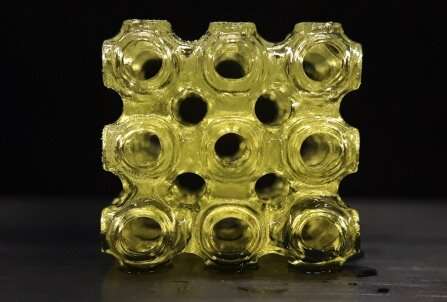Researchers develop new molecular ferroelectric metamaterials

A University at Buffalo-led research team has reported a new 3-D-printed molecular ferroelectric metamaterial.
The advancement, published Monday in the Proceedings of the National Academy of Sciences, is a step toward making these extraordinary lab-created materials more affordable and adaptable to countless multifunctional technologies. It could benefit everything from acoustic blankets for aircraft soundproofing to shock absorbers and elastic cloaks that shield sensitive electronic systems from external mechanical disturbances.
"The sky is the limit when it comes to ferroelectric metamaterials," says the study's lead author, Shenqiang Ren, Ph.D., professor in the Department of Mechanical and Aerospace Engineering at the UB School of Engineering and Applied Sciences.
Among the research interests of Ren, who holds appointments in UB's Department of Chemistry and the university's RENEW Institute, is the design and assembly of high-temperature molecular ferroelectrics. For the study, he assembled a team that includes:
- Chi Zhou, Ph.D., associate professor in UB's Department of Industrial and Systems Engineering. He led the 3-D printing part of the project.
- Mostafa Nouh, Ph.D., associate professor in UB's Department of Mechanical and Aerospace Engineering. He led the metamaterials component.
- Jeffrey C. Grossman, head of the Department of Materials Science and Engineering at the Massachusetts Institute of Technology (MIT). He led the computational materials design work.
Six graduate student researchers—led by Yong Hu in Ren's lab, Zipeng Guo in Zhou's lab and Andrew Ragonese in Nouh's lab—are among the study co-authors.
A metamaterial is any material engineered to have a property that is not found in naturally occurring materials. Ferroelectricity relates to crystalline substances that have spontaneous electric polarization that's reversible by an electric field.
In recent decades, researchers have been studying how to merge materials with these properties. While progress has been made, researchers have struggled to produce ferroelectric metamaterials that are cost effective and easily adaptable to electronic and mechanical devices.
The new study takes aim at these problems by utilizing the latest advancements in computing, additive manufacturing, materials design, acoustics and other fields.
The research team devised a plan to 3-D print a scaffold-supported ferroelectric crystalline lattice made of imidazolium perchlorate.
An emerging advanced manufacturing technology, 3-D printers can directly fabricate products from digital design with precise control on structures, materials and functionalities, Zhou says. In turn, this creates opportunities to advance material discoveries and expand industrial applications.
The findings, Ren says, pave the way for the use of 3-D printers to create molecular ferroelectric metamaterials. The unique design of the lattice enables it to self-correct any deviations from the design while the material is still being printed. Also, the material's stiffness—how much it resists deformation—is reprogrammable, which, in turn, allows researchers to "tune" the material to filter out different subwavelength frequencies.
On paper, Nouh says, metamaterials provide a unique platform to achieve unprecedented control over sound propagation and acoustic wave manipulation. Such potential can only be realized if researchers are able to create such materials—a goal which this work moves toward.
The work was partially funded by the U.S. Army Research Office (ARO).
"One of the reasons ARO is funding professor Ren's project is that molecular ferroelectrics are amenable to bottom-up processing methods—like 3-D printing—that would otherwise be challenging to use with traditional ceramic ferroelectrics," said Evan Runnerstrom, Ph.D., program manager Army Research Office, an element of the U.S. Army Combat Capabilities Development Command's Army Research Laboratory. "This paves the way for tunable metamaterials for vibration damping or reconfigurable electronics, which could allow future Army platforms to adapt to changing conditions."
More information: Yong Hu et al. A 3D-printed molecular ferroelectric metamaterial, Proceedings of the National Academy of Sciences (2020). DOI: 10.1073/pnas.2013934117
Journal information: Proceedings of the National Academy of Sciences
Provided by University at Buffalo





















